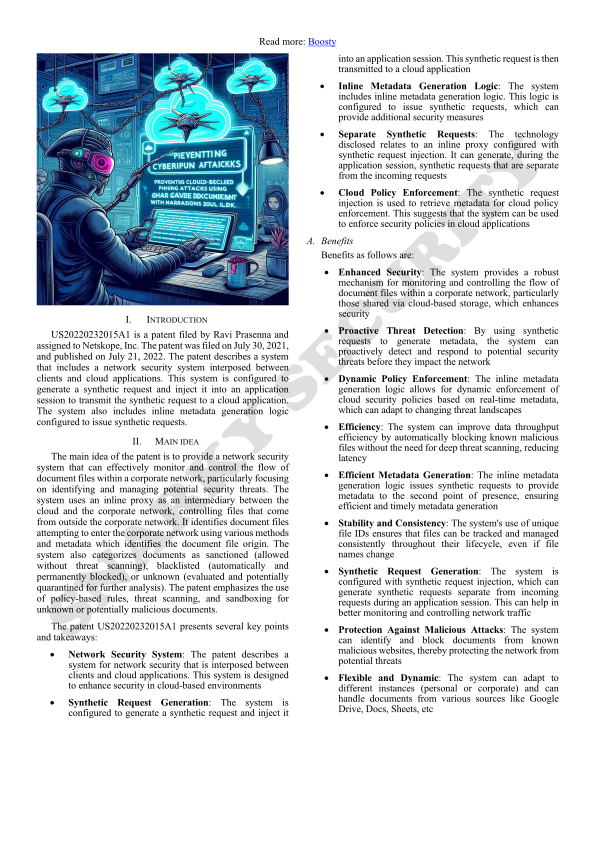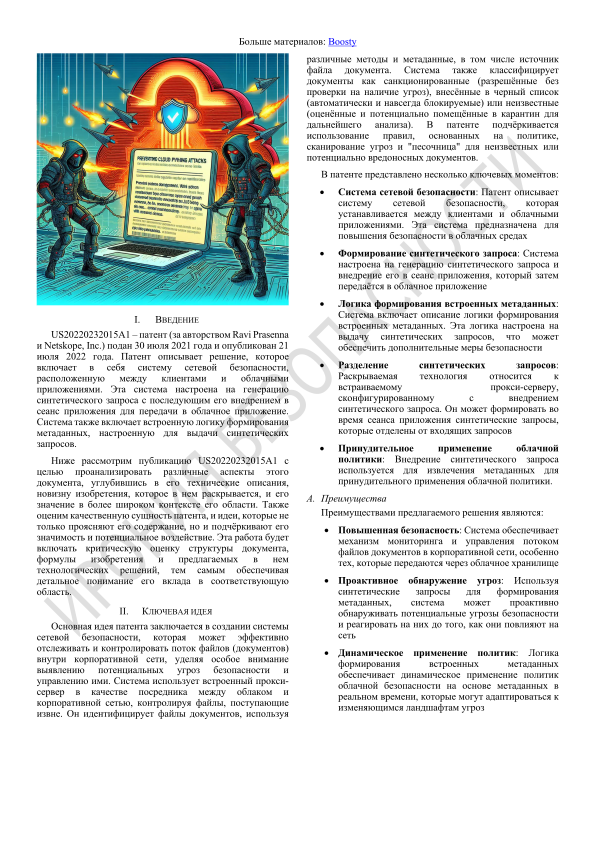Patent US20220232015A1 / Preventing cloud-based phishing attacks using shared documents with malicious links

Another patent that promises to revolutionize the thrilling world of network security with US20220232015A1. Brace yourselves for a riveting tale of inline proxies, synthetic requests, and the ever-so-captivating inline metadata generation logic. It’s like the Avengers, but instead of superheroes, we have network security components saving the day.
It’s essentially a glorified bouncer for your corporate network, deciding which document files get to strut down the digital red carpet and which ones get the boot. This system, armed with an inline proxy (because apparently, «inline» makes anything sound more tech-savvy), stands guard between the cloud and the corporate network like a knight in shining armor—except it’s fighting off data packets instead of dragons.
This system doesn’t just blindly swing its sword at anything that moves. Oh no, it’s got finesse. It identifies document files trying to sneak into the corporate network using «various methods and metadata, » which is a fancy way of saying it’s really nosy and likes to snoop around. And then, like a judgy gatekeeper, it categorizes these documents into three cliques: the sanctioned (the cool kids allowed in without a fuss), the blacklisted (the troublemakers permanently exiled to the land of «Access Denied»), and the unknown (the mysterious strangers who need a thorough background check).
The patent goes on to wax poetic about the use of policy-based rules, threat scanning, and sandboxing for those unknown or potentially malicious documents. Because nothing says «cutting-edge technology» like treating every document like it’s a ticking time bomb.
Let’s dive into this page-turner, shall we?
First off, we have the «Network Security System, » a groundbreaking invention that—hold your applause—acts as a middleman between clients and cloud applications. Because if there’s anything we need, it’s more intermediaries in our lives, right? This system is so dedicated to enhancing security in cloud-based environments that it practically wears a cape.
Next up, «Synthetic Request Generation.» The system doesn’t just handle requests; oh no, it creates its own. Because why wait for trouble when you can conjure it up yourself? It’s like inviting a vampire into your house just to see if your garlic wreath works.
And let’s not forget the «Inline Metadata Generation Logic.» This isn’t just any logic; it’s inline, which means… something very important, no doubt. It’s configured to issue synthetic requests, adding an extra layer of complexity because, clearly, what our lives lack is complexity.
Then there’s the «Separate Synthetic Requests.» Because why have one type of synthetic request when you can have two? Variety is the spice of life, after all. This technology is like having a decoy duck in a pond full of real ducks, except the ducks are data, and no one’s really sure why we need the decoy in the first place.
Ah, «Cloud Policy Enforcement, » the pièce de résistance. The synthetic request injection is used to retrieve metadata for cloud policy enforcement, suggesting that, yes, we can enforce policies in cloud applications. Because if there’s one thing cloud applications were missing, it was more policies.
Now, for the grand finale: the benefits and drawbacks.
Benefits:
🗣"Enhanced Security»: Because before this patent, everyone was just winging it.
🗣"Proactive Threat Detection»: It’s like Minority Report for your network, but without Tom Cruise.
🗣"Dynamic Policy Enforcement»: Finally, a way to enforce those policies dynamically. Static policy enforcement is so 2020.
🗣"Efficiency»: Because nothing says efficiency like generating synthetic requests to test your own system.
🗣"Stability and Consistency»: Because if there’s one thing we crave in the fast-paced world of IT, it’s stability. Yawn.
Drawbacks:
🗣"Complexity»: Who would’ve thought adding several layers of synthetic requests and metadata logic would make things more complex?
🗣"False Positives/Negatives»: Surprise! The system that invents its own problems sometimes gets it wrong.
🗣"Maintenance and Updates»: Because the one thing IT departments complain about not having enough of is maintenance work.
🗣"User Experience Impact»: Because nothing enhances user experience quite like being told your legitimate document is a security threat.
🗣"Over-Reliance on Known Threats»: Because who needs to worry about unknown threats when you can just keep focusing on the ones you already know?
So there you have it, folks. Patent US20220232015A1 is set to revolutionize the way we think about network security, turning the mundane task of document file management into a saga worthy of its own epic trilogy. Move over, Lord of the Rings; there’s a new tale of adventure in town, complete with inline proxies, metadata, and the ever-thrilling sandboxing. Who knew network security could be so… exhilarating?
Unpacking in more detail







